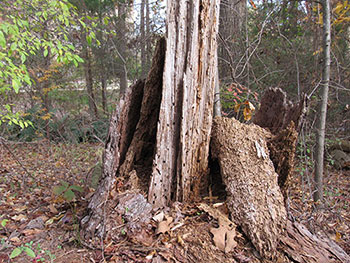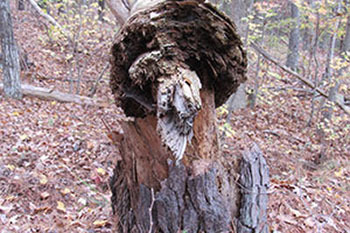What's Hiding in That Dead Tree?
What's Hiding in That Dead Tree?
By Bill Willis and Bill Steinmetz
January 11, 2018

(Photo courtesy of Bill Willis)
Got a dead tree? Grab the saw, cut it up, and be gone with it! It’s not serving any purpose now. Right? Are you sure that there’s no life hidden there?
Is the tree whether standing or lying on the ground really dead? Everyone would probably agree that it is personally more satisfying to hug a living, sap flowing, upright landscape tree than a bark peeling beetle ridden one. But shouldn’t providing a habitat beyond death be lauded in the case of the dead tree?
Actually trees, depending on how long they have been without foliage, have a variety of wildlife that live on, in, under, and around them.
Our Grounds Maintenance Contract allows for felling a dead tree snag that is within fifty feet of a pedestrian walkway or street if it poses a safety concern should it fall. Otherwise, the tree would be left upright, with those requiring cutting, left to decay on the ground. Limbs and plant trimmings can be placed deep in the woods for erosion control and natural composting. None of this material leaves the campus. These actions maintain safety as well as benefit wildlife and small animals that can take advantage of cover and food source.

(Photo courtesy of Bill Willis)
What is the benefit that dead trees provide? The dead trees provide resting places for lizards, rodents, and small predators. Many a turtle has sunned on a log. If the trees are hollow, they make good hiding places in the summer even places for bird and squirrel to nest. Logs can be used as dens in the winter for reptiles and mammals needing a warm place.
Logs also offer up food and shelter for beetles, bees, ants and termites. Some beetle grubs may have substantially contributed to the tree’s demise and now provide habitat for other beetle grubs. Slim molds and fungi get nourishment and in turn provide additional food sources.
All these factors make a good environment for centipedes, worms, spiders, beetle larva, and amphibians.
It you have a wildlife habitat, try to make room for decaying logs for you may be surprised at the variety of living plants and animals that will call it home. It’s well over a thousand species.



